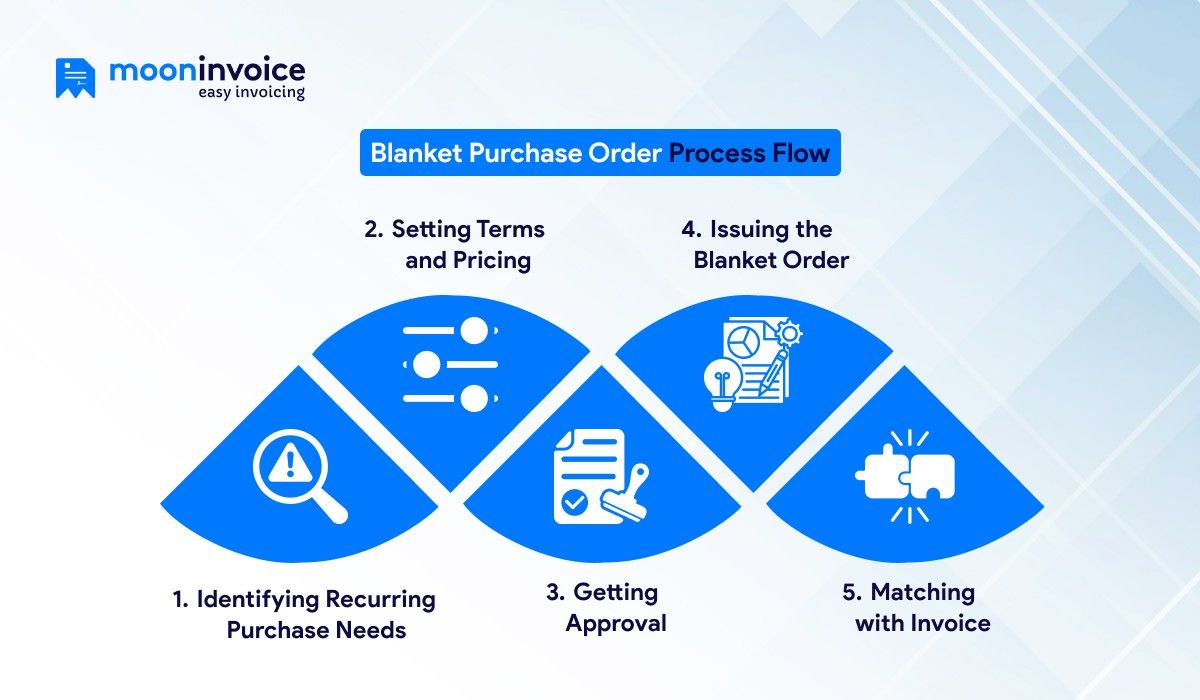Blanket Purchase Order Definition:
A blanket purchase order is a financial document that serves as a long-term contract between the buyer and seller, intended to simplify the ordering process and save time.
Introduction
As a business owner, it is almost undeniable to rely on recurring suppliers for goods or services. It can be raw materials for construction or electronic gadgets for a store; the buying and selling never stop. But when you are already handling so many business operations, manually managing these repetitive buying and selling processes can become time-consuming and expensive.
So, what to do? This is where blanket purchase orders come into play. It is a solution that simplifies the logistics and planning for everyone involved. For larger companies, it is even more valuable as it builds trust with vendors.
In this blog, we will explore what is a blanket PO, its uses, process, benefits, and potential challenges.
Let’s jump straight into the topic.
📌 Key Takeaways
- A blanket purchase order is issued instead of a regular purchase order for repeated purchases from a supplier.
- A blanket PO can be used in case of recurring purchases of goods or services or predictable consumption patterns.
- The BPO process flow involves identifying needs, setting terms, getting approval, issuing the BPO, and matching the invoice with the PO.
- The top benefits of using a blanket PO include saving time, maintaining pricing stability, and avoiding stockout or over-stocking.
- A purchase order system can be used to create blanket POs and avoid manual work.
What is a Blanket Purchase Order? (Blanket PO Meaning)
A blanket purchase order is also termed a standing purchase order. It is a financial document that serves as a long-term contract between the buyer and the supplier for the purchase of a specific set of goods or services over a defined period.
In general, whenever a business needs to buy an item, a purchase order must be created. However, under a blanket purchase order, the buyer can make multiple purchases under a single contract. It saves time and makes businesses more flexible.
For instance, if a company issues a blanket purchase order for office stationery, it ensures a reliable supply of these essential items is available whenever needed. It reduces the need for repeated negotiations and provides a seamless ordering process whenever supplies run low.
A blanket purchase order includes the following:
- Product or service description
- Pricing and quantity limits
- Delivery schedule or timeline
- Validity period
- Payment and invoicing terms
We have understood “what is a blanket PO.” Next, we will discuss the scenarios in which it can be used.
Are You Struggling to Manage Purchase Orders Manually?
Repeated errors, missing approvals, and lost paperwork can derail your procurement. Switch to a smarter, organized way of managing POs with Moon Invoice.
When Should You Use a Blanket Purchase Order?
A blanket PO differs from other types of purchase orders and may not suit every purchase. Businesses that make repetitive or predictable purchases from the supplier for a specific period can use a blanket PO. The objective of using a BPO is to simplify the buying process and maintain consistency across transactions.
Below are some of the ideal situations to use a blanket purchase order:
1. Recurring Purchases of Goods or Services
Using individual purchase orders for frequent buying of the same materials or maintenance services can become cumbersome. In such cases, a BPO can be used, which doesn’t require reapprovals or new paperwork.
2. Long-Term Vendor Relationships
Suppose you have a supplier for a very long period and have established trust with stable pricing. In this case, you can use a blanket order, which will ease the ongoing transaction and enable smoother vendor collaboration.
3. Predictable Consumption or Demand Patterns
If your business analyst team can predict the future demand of goods or services to run the business successfully, a BPO can be used. For example, a construction company purchases bulk cement packages to accomplish a project. Here, BPO will avoid the risk of stockouts and over-ordering.
4. To Minimize Duplicacy
Large organizations with multiple departments or branches can look forward to issuing blanket purchase orders, as they provide greater clarity and reduce order duplication.
5. Administrative Efficiency
If the purchase order process is done manually — i.e., creating, approving, and tracking POs — it will take a lot of time. In such cases, you can create a BPO using invoicing software that not only automates usage tracking but also accelerates purchasing cycles.
💡Also read:
The Blanket Purchase Order Process Flow

The blanket order system may vary across businesses, but here is a general guide to the steps involved.
1. Identifying Recurring Purchase Needs
When you run a business, you will deal with a number of purchase orders from various suppliers. So, to create a blanket purchase order, there needs to be some valid reasons.
Identify what items or services your organization repeatedly buys over time. It could be anything from raw materials to office supplies to logistics support, etc. The procurement team must analyze vendor history, monthly usage, and past consumption patterns to find out which purchases qualify for a long-term agreement.
2. Setting Terms and Pricing
The needs are identified, and now the buyer negotiates all terms with the supplier.
Here, terms and pricing refer to the duration of the BPO and the price of each item during this period. If the BPO validity is long enough — for example, more than 6 months — there may be applicable small discounts. This step also involves clearly defining order quantity limits and delivery schedules.
This step is necessary because both the buyer and supplier must be on the same page with all the pricing and expectations.
3. Getting Approval
After setting the terms and pricing for the BPO, you need to make sure the internal team approves it. The internal team’s approval ensures accountability and better financial control. This is the job of finance teams and procurement managers to review and analyze the blanket PO.
Once approved, you can now issue the blanket purchase order.
4. Issuing the Blanket Order
Now that both the buyer and the supplier have agreed on the terms, it’s time to issue the blanket purchase order. You can include supplier details, contract validity dates, approved products or services, and agreed-upon pricing in the blanket PO.
The next step is to match the invoice with the purchase order. The invoice-matching process must be followed correctly to avoid discrepancies.
5. Matching with Invoice
Invoice matching is the final step in the blanket purchase order process.
Upon receiving the invoice, the procurement team validates that the delivered items, prices, and quantities align with the agreed terms. The supplier’s invoice is checked against the original blanket PO and release records before payment is processed.
For more clarity and better understanding, you can consider three-way invoice matching. It simplifies the auditing process and saves both cost and time.
💡DID YOU KNOW?
A PO in use enhances the procurement process, and companies with a well-managed procurement process save nearly 4.9% in annual costs.
Benefits of Using Blanket Purchase Orders
Blanket purchase orders are common in procurement departments because they are an easy way to reduce costs and build stronger supplier relationships.
Let’s explore the major benefits of using blanket purchase orders.
- Saves Time and Reduces Paperwork: For recurring needs, repeated purchases can be made under one agreement instead of multiple purchase orders.
- Ensures Pricing Stability: Issues such as unexpected cost changes and frequent price fluctuations are avoided, as they are pre-negotiated during blanket PO creation. The buyer may get bulk discounts for large orders.
- Long-Term Supplier Relationships: With better pricing, timely delivery, and prioritized service quality, the long-term relationship between the buyer and supplier improves.
- Improves Inventory Management: Minimal risk of overstocking or stockouts as goods are delivered in intervals and managed properly.
- Simplifies Invoicing: As every transaction falls under the same contract, it is easier to match invoices and process payments.
Challenges Involved in Blanket Purchase Orders
It is true that blanket POs offer flexibility and efficiency, but there are certain things that need careful attention. Overlooking them could create financial and operational issues.
1. Risk of Over Commitment
With a blanket purchase order in place, the risk of over-commitment increases as it covers a long period. If the usage of goods is lower than expected, it will result in reduced cost savings.
2. Quality or Performance Issues
A BPO means that one supplier is guaranteed for repetitive purchases for a certain period, and this creates a loophole in the system. Some suppliers may compromise quality or delivery timelines.
3. Complex to Track Each Purchase
If a business’s entire procurement process depends on a single blanket order, it will be difficult to retrieve data. It could mix up everything, which leads to confusion and inefficient tracking.
4. Legal and Compliance Risk
A blanket purchase order becomes a binding contract once approved. If terms are unclear or poorly negotiated, disputes may arise around delivery, pricing, or quantities.
How to Effectively Manage Blanket PO?
Managing a blanket purchase order is not that simple. You have to continuously monitor suppliers, spending, required quantities (in case stocks are ending), and perform accurate invoice matching. Manually completing all these tasks requires a lot of time, and there is a higher risk of errors. This is the reason why using purchase order automation software is key.
Tools such as Moon Invoice make the procurement faster and keep businesses organized. With Moon Invoice, businesses can easily track each delivery, monitor total spending, and verify invoices without requiring any manual paperwork.
Here’s how Moon Invoice simplifies the entire purchase order process:
- Helps you track all purchase releases in one platform.
- Usage limits and remaining quantities are updated in real-time.
- You can perform invoice matching in less time.
- Dedicated vendor portal that gives complete visibility of vendor activity.
- Ensures an efficient approval process and reduces administrative burden.
Moon Invoice helps you scale operations and maintain vendor transparency throughout the contract period.
The Bottom Line
Blanket purchase orders instead of regular purchase orders are a smart choice. The benefits are higher, but it requires good analysis and trusted vendor relationships to use for a long time.
Also, if you use BPO manually, things can go from good to bad very quickly. The chances of making an error increase, processing time increases, and tracking each purchase becomes very difficult.
So, what to do? You can consider using an automation tool such as Moon Invoice in your workflow. It will help you process blanket POs faster without errors. Start your free trial today!




















